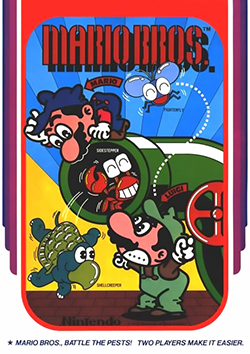
Mario Bros. is a platform game developed and published by Nintendo as an arcade video game in 1983. It was designed by Shigeru Miyamoto and Gunpei Yokoi, Nintendo's chief engineer. Italian twin brother plumbers Mario and Luigi exterminate creatures, like turtles (Koopas) and crabs emerging from the sewers by knocking them upside-down and kicking them away. The Famicom/Nintendo Entertainment System version is the first game produced by Intelligent Systems. It is part of the Mario franchise, but originally began as a spin-off from the Donkey Kong series.

Super Mario Bros. 3 is a 1988 platform game developed and published by Nintendo for the Nintendo Entertainment System (NES). It was released for home consoles in Japan on October 23, 1988, in North America on February 12, 1990 and in Europe on August 29, 1991. It was developed by Nintendo Entertainment Analysis and Development, led by Shigeru Miyamoto and Takashi Tezuka.

Super Mario World, known in Japanese marketing as Super Mario World: Super Mario Bros. 4, is a platform game developed by Nintendo EAD and published by Nintendo for the Super Nintendo Entertainment System (SNES). It was released in Japan in 1990, North America in 1991 and Europe and Australia in 1992. The player controls Mario on his quest to save Princess Peach and Dinosaur Land from the series' antagonist Bowser and the Koopalings. The gameplay is similar to that of earlier Super Mario games; players control Mario through a series of levels in which the goal is to reach the goalpost at the end.

Luigi is a fictional character featured in video games and related media released by Nintendo. Created by Japanese video game designer Shigeru Miyamoto, Luigi is portrayed as the younger fraternal twin brother and sidekick of Mario. Defined by his kind-hearted, yet cowardly demeanor, Luigi appears in many games throughout the Mario franchise, oftentimes accompanying his brother.

Mario is a character created by the Japanese video game designer Shigeru Miyamoto. He is the title character of the Mario franchise and the mascot of the Japanese video game company Nintendo. Mario is an Italian plumber who resides in the Mushroom Kingdom with his younger twin brother, Luigi. Their adventures generally center on rescuing Princess Peach from the villain Bowser while using power-ups that give them different abilities.

Princess Peach is a character in Nintendo's Mario franchise. She was created by Shigeru Miyamoto and introduced in the 1985 original Super Mario Bros. installment as Princess Toadstool. She is the princess regnant and head of state of the Mushroom Kingdom, where she resides in her castle along with Toads. Since her debut, she has appeared in the majority of Mario video games as the main female character and the romantic interest of Mario. She has been voiced by Samantha Kelly since 2007.

Paper Mario is a 2000 role-playing game developed by Intelligent Systems and published by Nintendo for the Nintendo 64 home video game console. Paper Mario is the first game in the Paper Mario series. First released in Japan in 2000 and then internationally in 2001, Paper Mario was later re-released for Nintendo's Wii Virtual Console in July 2007, the Wii U Virtual Console in April 2015, and the Nintendo Switch Online + Expansion Pack on December 10, 2021.
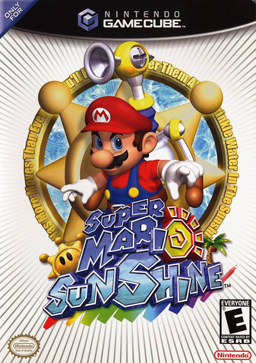
Super Mario Sunshine is a 2002 platform game developed and published by Nintendo for the GameCube. It is the second 3D game in the Super Mario series, following Super Mario 64 (1996). The game was directed by Yoshiaki Koizumi and Kenta Usui, produced by series creators Shigeru Miyamoto and Takashi Tezuka, written by Makoto Wada, and scored by Koji Kondo and Shinobu Tanaka.

Koji Kondo is a Japanese music composer, pianist, and sound director for the video game company Nintendo. He was best known for his many contributions to the Super Mario and The Legend of Zelda series of video games, among others produced by the company. Kondo was hired by Nintendo in 1984, becoming the first person hired by them to specialize in video game music. His work in the Mario and Zelda series have been cited as the most memorable in video games, such as the Super Mario Bros. overworld theme.

Excitebike is a motocross racing video game developed and published by Nintendo. In Japan, it was released for the Famicom in 1984 and then ported to arcades as VS. Excitebike for the Nintendo VS. System later that year. In North America, it was initially released for arcades in 1985 and then as a launch game for the Nintendo Entertainment System later that year, becoming one of the best-selling games on the console. It is the first game in the Excite series.
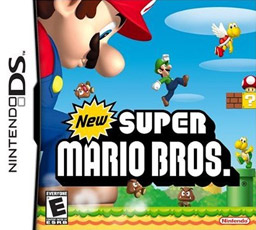
New Super Mario Bros. is a 2006 platform game developed and published by Nintendo for the Nintendo DS. It was first released in May 2006 in North America and Japan, and in PAL regions in June 2006. It is the first installment in the New Super Mario Bros. subseries of the Super Mario franchise and follows Mario as he fights his way through Bowser's henchmen to rescue Princess Peach. Mario has access to several old and new power-ups that help him complete his quest, including the Super Mushroom, the Fire Flower, and the Super Star, each giving him unique abilities. While traveling through eight worlds with more than 80 levels, Mario must defeat Bowser Jr. and Bowser before saving Princess Peach.

Super Mario Galaxy is a 2007 platform game developed and published by Nintendo for the Wii. It is the third 3D game in the Super Mario series. As Mario, the player embarks on a quest to rescue Princess Peach, save the universe from Bowser, and collect 120 Power Stars, after which the player can play the game as Luigi for a more difficult experience. The levels consist of galaxies filled with minor planets and worlds, with different variations of gravity, the central element of gameplay. The player character is controlled using the Wii Remote and Nunchuk and completes missions, fights bosses, and reaches certain areas to collect Power Stars. Certain levels use the motion-based Wii Remote functions.

Super Mario is a platform game series created by Nintendo starring their mascot, Mario. It is the central series of the greater Mario franchise. At least one Super Mario game has been released for every major Nintendo video game console. However, there have also been a number of Super Mario video games released on non-Nintendo gaming platforms. There are more than 20 games in the series.

Mario is a Japanese multimedia franchise created by Japanese game designer Shigeru Miyamoto for video game company Nintendo which produces and publishes its installments. Starring the titular Italian plumber Mario, it is primarily a video game franchise, but has extended to other forms of media, including television series, comic books, a 1993 feature film, a 2023 animated film and theme park attractions. The series' first installment was 1983's Mario Bros., although Mario had made his first appearance in 1981's arcade game Donkey Kong, and had already been featured in several games of the Donkey Kong and Game & Watch series. The Mario games have been developed by a wide variety of developers including Nintendo, Hudson Soft, and AlphaDream. Mario games have been released almost exclusively for Nintendo's various video game consoles and handhelds, from the third generation onward.

New Super Mario Bros. Wii is a 2009 platform game developed and published by Nintendo for the Wii. A follow-up to New Super Mario Bros., it was first released in Australia, North America, and Europe in November 2009, followed by Japan a month later. A high-definition port for the Nvidia Shield TV was released in China in December 2017. Like other side-scrolling Super Mario games, the player controls Mario as he travels eight worlds and fights Bowser's henchmen to rescue Princess Peach. New Super Mario Bros. Wii was the first Super Mario game to feature simultaneous cooperative multiplayer gameplay; up to four people can play in cooperative and competitive multiplayer modes, taking control of Mario as well as Luigi and one of two multicolored Toads. The game also introduces "Super Guide", which allows the player to watch a computer-controlled character complete a level.
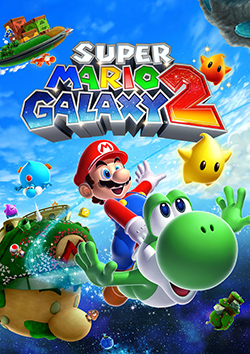
Super Mario Galaxy 2 is a 2010 platform game developed and published by Nintendo for the Wii. It was first announced at E3 2009 and is the sequel to 2007's Super Mario Galaxy. It was released worldwide in 2010. Much like the first game, the story follows Mario as he pursues the Koopa King, Bowser, into outer space, where he has imprisoned Princess Peach and taken control of the universe using Power Stars and Grand Stars. Mario must travel across various galaxies to recover the Power Stars in order to travel to the center of the universe and rescue Princess Peach.
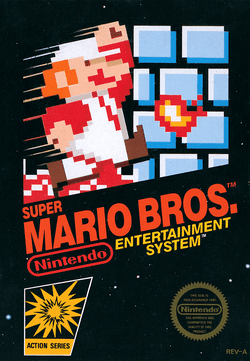
Super Mario Bros. is a platform game developed and published in 1985 by Nintendo for the Famicom in Japan and for the Nintendo Entertainment System (NES) in North America. It is the successor to the 1983 arcade game Mario Bros. and the first game in the Super Mario series. Following a US test market release for the NES, it was converted to international arcades on the Nintendo VS. System in early 1986. The NES version received a wide release in North America that year and in PAL regions in 1987.

The Super Mario Bros. Movie is a 2023 American animated adventure comedy film based on Nintendo's Mario video game franchise. Produced by Universal Pictures, Illumination, and Nintendo, and distributed by Universal, it was directed by Aaron Horvath and Michael Jelenic and written by Matthew Fogel. The ensemble voice cast includes Chris Pratt, Anya Taylor-Joy, Charlie Day, Jack Black, Keegan-Michael Key, Seth Rogen, and Fred Armisen. The film features an origin story for the brothers Mario and Luigi, Italian-American plumbers who are separated after being transported to a fantasy world and become entangled in a battle between the Mushroom Kingdom, led by Princess Peach, and the Koopas, led by Bowser.

The Super Mario Bros. Movie is the soundtrack to the 2023 film of the same name, based on Nintendo's Mario video game franchise. The original score for the film is composed by Brian Tyler, who incorporated and remixed the original themes from longtime Mario composer Koji Kondo under his collaboration. According to Tyler, he wanted to "incorporate the music that I heard in that 8-bit form and along the way bring it into the world of a big epic, emotional film score." This resulted in partly original music that referenced several leitmotifs from various Mario games as well as themes from Donkey Kong.




















